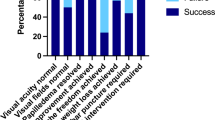Abstract
Purpose
To describe the clinical features and visual outcomes of idiopathic intracranial hypertension (IIH) in Chinese patients.
Methods
We retrospectively reviewed the charts of patients diagnosed with IIH in Taipei Veterans General Hospital from 1981 to 2009. Demographic data, clinical features, laboratory data, treatment, and visual outcomes were analyzed.
Results
Twelve patients were included, seven female and five male patients. The mean age at onset was 32 (range, 13–65) years. Obesity was found in four (33%) patients. The most common clinical symptom was headache (75%), followed by transient visual obscuration (42%) and tinnitus (17%). Snellen visual acuity was equal to or better than 20/30 in 23 eyes, and the only eye with vision worse than 20/50 vision belonged to a patient who had been amblyopic since childhood. Visual field defects were detected in seven eyes by either Goldmann or automated perimetry. Generalized depression and an enlarged blind spot were the most common patterns. Ten patients were found to have bilateral disc edema. One patient with unilateral papilledema and one patient without papilledema were identified in the study.
Conclusions
In IIH in Chinese, men are more likely to be affected than women, but obesity is not as frequent as reported in Western countries. Visual function outcomes are more favorable in Chinese patients.
Similar content being viewed by others
References
Wall M. Idiopathic intracranial hypertension. Neurol Clin 1991; 9:73–95.
Giuseffi V, Wall M, Siegel PZ, Rojas PB. Symptoms and disease associations in idiopathic intracranial hypertension (pseudotumor cerebri): a case-control study. Neurology 1991;41:239–243.
Durcan FJ, Corbett JJ, Wall M. The incidence of pseudotumor cerebri. Population studies in Iowa and Louisiana. Arch Neurol 1988;45:875–877.
Radhakrishnan K, Ahlsog JE, Cross SA, Kurland LT, O’Fallon WM. Idiopathic intracranial hypertension (pseudotumor cerebri). Descriptive epidemiology in Rochester, Minn 1976 to 1990. Arch Neurol 1993;50:78–80.
Wilson DH, Gardner WJ. Benign intracranial hypertension with particular reference to its occurrence in fat young women. Can Med Assoc J 1966;95:102–105.
Rush JA. Pseudotumor cerebri; clinical profile and visual outcome in 63 patients. Mayo Clin Proc 1980;55:541–546.
Yabe I, Moriwaka F, Notoya A, Ohtaki M, Tashiro K. Incidence of idiopathic intracranial hypertension in Hokkaido, the northernmost island of Japan. J Neurol 2000;247:473–475.
Hung HL, Kao LY, Huang CC. Ophthalmic features of idiopathic intracranial hypertension. Eye 2003;17:793–795.
Kim TW, Choung HK, Khwarg SI, Hwang JM, Yang HJ. Obesity may not be a risk factor for idiopathic intracranial hypertension in Asians. Eur J Neurol 2008;15:876–879.
Bruce BB, Preechawat P, Newman NJ, Lynn MJ, Biousse V. Racial differences in idiopathic intracranial hypertension. Neurology 2008;70:861–867.
Celebisoy N, Secil Y, Akyurekli O. Pseudotumor cerebri: etiological factors, presenting features and prognosis in the western part of Turkey. Acta Neurol Scand 2002;106:367–370.
Radhakrishnan K, Ahlskong JE, Garrity JA, Kurland LT. Idiopathic intracranial hypertension. Mayo Clin Proc 1994;69: 169–180.
Corbett JJ, Savino PJ, Thompson HS, et al. Visual loss in pseudotumor cerebri; follow up of 57 patients from five to 41 years and a profile of 14 patients with permanent severe visual loss. Arch Neurol 1982;39:461–474.
Wall M, George D. Idiopathic intracranial hypertension; a prospective study of 50 patients. Brain 1991;114:155–180.
Wall M, White WN II. Asymmetric papilledema in idiopathic intracranial hypertension. Prospective interocular comparison of sensory visual function. Invest Ophthalmol Vis Sci 1998;39: 132–142.
Orcutt JC, Page NGR, Sanders MD. Factors affecting visual loss in benign intracranial hypertension. Ophthalmology 1984;91:1303–1312.
Wall M, George D. Visual loss in pseudotumor cerebri: incidence and defects related to visual field strategy. Arch Neurol 1987; 44:170–175.
Lipton HI, Michelson PE. Pseudotumor cerebri syndrome without papilledema. JAMA 1972;220:1591–1592.
Marcelis John, Silberstein SD. Idiopathic intracranial hypertension without papilledema. Arch Neurol 1991;48:392–399.
Tso MOM, Hayreh SS. Optic disc edema in raised intracranial pressure, IV: axoplasmic transport in experimental papilledema. Arch Ophthalmol 1997;95:1458–1462.
Spence JD, Amacher AL, Willis NR. Benign intracranial hypertension without papilledema: role of 24-hour cerebrospinal fluid pressure monitoring in diagnosis and management. Neurosurgery 1980;7:326–336.
Killer HE, Jaggi GP, Flammer J, Miller NR, Huber AR, Mironov A. Cerebrospinal fluid dynamics between the intracranial and subarachnoid space of the optic nerve. Is it always bidirectional? Brain 2007;130:514–520.
Author information
Authors and Affiliations
Corresponding author
About this article
Cite this article
Liu, IH., Wang, AG. & Yen, MY. Idiopathic intracranial hypertension: Clinical features in Chinese patients. Jpn J Ophthalmol 55, 138–142 (2011). https://doi.org/10.1007/s10384-010-0907-9
Received:
Accepted:
Published:
Issue Date:
DOI: https://doi.org/10.1007/s10384-010-0907-9




